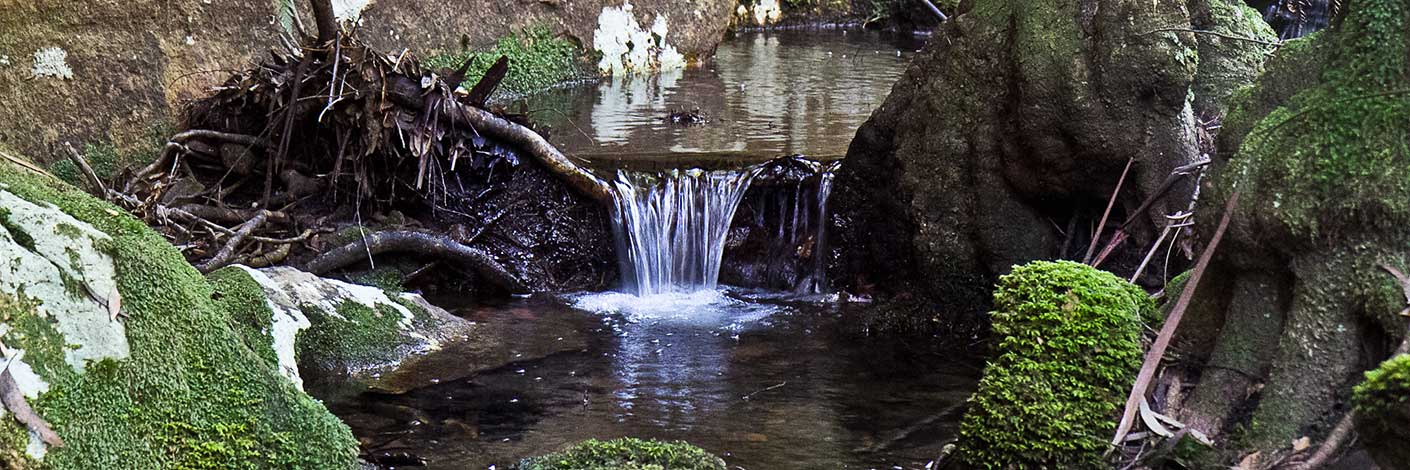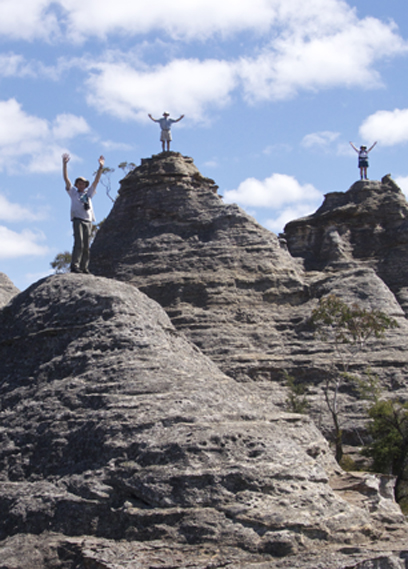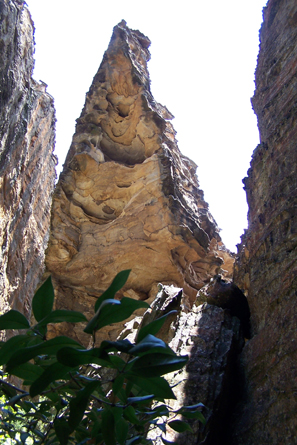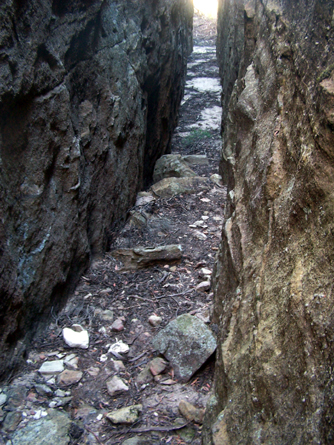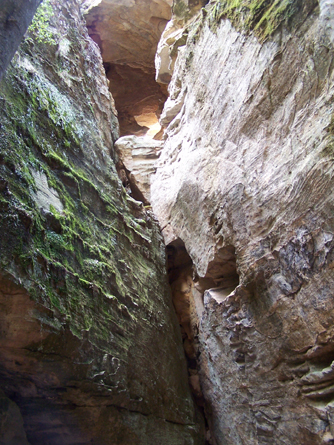Bush Explorers Encyclopaedia
The Slip Rails
Is a narrow ridge line between two drainage patterns on Mount Cameron Trail, 2.7km west, north west of Mount Cameron. Ref: Correspondence with Danny Whitty, 3rd July 2010. Local usage name, prior to 1980s. This would have been an ideal location to construct slip rails across this narrow ridge to control stock movement.
The Sphinx
Is a singular rock structure on Tresure Point, that when viewed from a particular angle, resembles an Egyptian Stone Sphinx. Located on the south east extremity of the Valley of the Kings. Name created by the original three who were jointly responsible for the name, The Gardens of Stone National Park, proposed by Rodney Falconer. The three were, Rodney Falconer, David Blackwell and Dr Haydn Washington, November 1984.
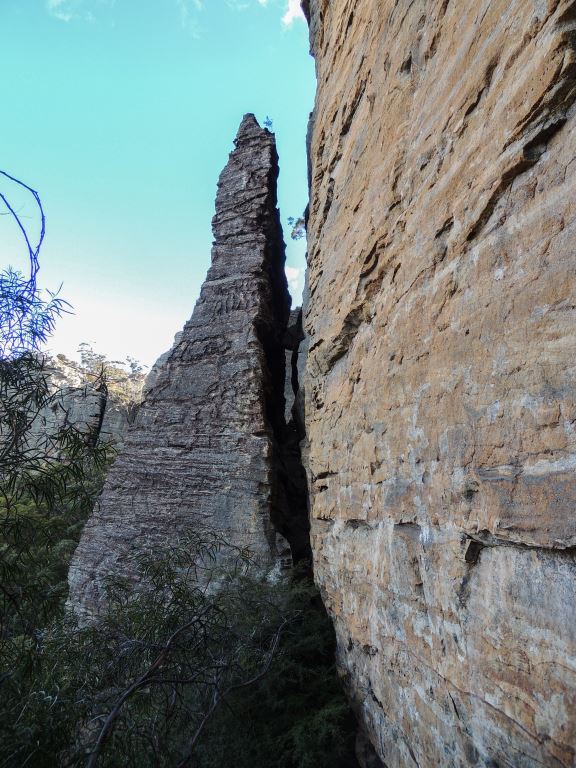
The Spire
Is a huge 40m high rock tower of ribbed grey sandstone, which has separated from the main cliff line. It is square at the bottom and tapered to a sharp point at the top. Located on the southern side of Donkey Mountain below the saddle that separates the The Columns from the eastern section of Donkey Mountain. Named by Brian Fox and Yuri Bolotin on a Bush Club walk 7th July 2017.
The Three Hundred Sisters
Refers to the hundreds of spectacular rock formations on Genowlan Mountain. The name is a "take off" of The Three Sisters at Katoomba, as in, 'Just three', at Genowlan there are three hundred. Name was coined by Dr Haydn Washington. Ref: National Parks Journal, October 1998.
The Towers
Are a line of rocky pagodas rising like towers from the tree canopy below. Located midway between Mount Airly and Blacks Corner. Best viewed from the western end of Airly Tramway Trail. Named by Dr Haydn Washington c1984.
The Trapdoor
So named by Yuri Bolotin, 29th August 2015, as a deep narrow parallel sided passageway has occurred due to a block of great dimensions that has moved out from the cliff face. The glide path is at 45 degrees from the point of detachment, so the passageway is the same width both before and after it has taken a 90-degree turn. Located below the cliff line within Hecates Cauldron.
The Trident
Was so named as three heavily dissected and pagoda encrusted ridges form a triple prong shape. Located above the headwaters of Koopartoo Ravine on the Koopartoo Mesa. Midway between Capertee Creek and Wolgan River. Named by Yuri Bolotin and Michael Keats on a Bush club walk, 6th May 2016.
The Wall
Is a highly eroded almost vertical rock face within a narrow canyon that is accessed via Glowworm Tunnel Road and Waratah Ridge Road. It is located 3.3km south, south east of the junction of Waratah Ridge Road and Two Trees Road and 200m to the north of Bungleboori Creek. Named by David Blackwell, 19th September 2010.
The Watchtower
Yuri Bolotin named this huge pagoda, located on the edge of the City in the Sky, at GR 2566 3240, 983m, on 7 August 2017.
The Whale
Is a rock formation on the track to Nobles Canyon. This distinctive rock with its wide open mouth and bulbous head has had many a photo with a person in its mouth. Brian Fox has referred to this name since 2010, but invariably has been known by similar names, ie The Shark.
Thom Slot
A slot with an easy grade internal ramp. Named by Brian Fox to give recognition to Surveyor William Stronach Thom (1871-1918). Employed for 30 years in the NSW Government Railways. Deane, Henry. The Wolgan Valley Railway – Its Construction, pp. 5-6, records, “The new surveyors included Mr. Thom who had previously held an appointment under me in the Department of Works….Mr Thom was instructed to work up the Sunnyside route….1906.”
Thorpes Constriction
Is a 2m drop in which water passes through a narrow slot, 1.9km east, south east of the junction of Waratah Ridge and Two Trees Roads. Named by Michael Keats on a Bush Club walk, 15th February 2009, after The Bush Club member, Ian Thorpe.
Thorpes Folly
Located 400m south west of Derailment Hill, was named by Caro Ryan in 2008 after Ian Thorpe suggested that it would be an easy walk across from the current location to the cliffs some 100m further north. It proved to be anything but easy.
Three Foot Track
Appears to be the original walking track from the Lithgow township to Hassans Walls. It ends at the top of Rutherford Glen.
Three Level Cave
Encompasses three levels, the top level being one to three metres wide, with the valley floor about 40m below. Located on the northern side of the junction of the Great Dividing Range and Ben Bullen Range. Named by Michael Keats on a Bush Club walk, 26th July 2013.
Three Mile Siding
Used to be a railway siding on the Wolgan Valley Railway, about 300m north east of Bald Trig Station. The railway (now road) wound around the eastern side of Bald Trig. Ref: Jacobi, C R. The Railway and Tramway Magazine, A Trip to Newnes Junction and the Wolgan Valley, 2nd May 1921.
Tiger Snake Canyon
The bottom section was discovered by a Sydney University - Ramblers trip in September 1977. When walking up this creek, they encountered a Tiger Snake. The day after when finalising a map of the area the name was coined by David Noble and Keith Maxwell. Ref: Map and correspondence Keith Maxwell 13th February 2016. Canyons Near Sydney by Rick Jamieson, 4th ed, p. 50.
Tiger Snake Canyon Track
Is accessed via Glowworm Tunnel Road and 4.2km along the Old Coach Road to a parking area and NPWS signage. The start of the track is on the east over a barrier and a couple of logs on an old firetrail. This track gives access to the such locations as the, Pentafid, Tiger Snake Canyon, Constance Point, Rock Island and Deanes Creek. Originally this track carried the Newnes Industrial Complex pre Wolgan Valley Railway telephone line to Newnes, c1905.
Tiger Snake Creek
Is a non perennial creek, 1km in length. It flows generally in an easterly direction into Deanes Creek. The creek junction is 400m south of Deanes Creek and Constance Gorge junction. Its name is derived from the name of the canyon.
Tiger Snake Point
Is the highest pagoda above and on the eastern side of Tiger Snake Canyon. It is also above the junction of Constance Gorge and Deanes Creek. Named by Yuri Bolotin on a Bush Club walk, 8th January 2016.
Tindalls Swamp
Is an area of swampy ground on the Wolgan River, 2km upstream of the Wolgan Falls. It is named after an old local timber cutter. The name was in use when the bullockies pulled timber from this area, up to the 1950s. Ref: Oral history, Ossie O'Brien, 20th April 2012.
Top of the Town
The highest area in the City in the Sky, GR 2569 3246, 990m. Named by Yuri Bolotin on 7 August 2017.
Torbane
Was a private village, constructed in 1889 for employees working the retort complex that processed kerosene shale transported by various means from the mines in the adjoining eastern valley of Airly. Torbane School opened in October 1899 and closed in September 1920. Torbane in NSW was named after a village of that name in Scotland which came to be associated with the Boghead Deposits discovered in 1844. At the time, the mineral Torbanite became known as Boghead Mineral. Commercial extraction of oil on the shores of the North Sea dates back to 1851, when James Young retorted oil from Torbanite. Ref: Eardley, G H. and Stephens, E M. The Shale Railways of NSW, 1974, p. 99.
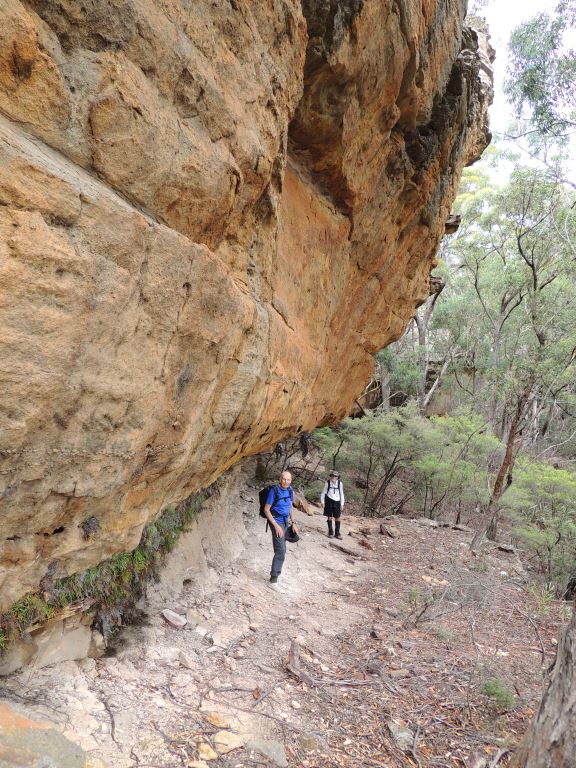
Torbane Balcony
Is located on the western side of Mount Airly, below the line of pagodas known as the Great Wall of China. The balcony seems to exist due to a soft band of shale, very possibly an extension of the Mount York Claystone band that features throughout much of the area. It has eroded much faster than the sandstone and created a more or less continuous convoluted bench for a little more than 300m. Named by Peter Medbury, 16th December 2016.
Torbane Blade
Is located 750 m west of Mount Airly, below Torbane Balcony. Named by Yuri Bolotin and Peter Medbury on a bushwalk 14 June 2021. Yuri recorded, "The opposite (northern) side of the blade is even more impressive, as it tapers down to an almost single point. Dimensionally, this feature is about 8 m high, 20 m long and has a variable width of 1 m to 20 cm; it is separated from the cliff line by a slot 1.5 m wide at one end and 30 cm wide at the other.".
Torbane Creek *
Is a non perennial stream rising on the western slopes of Mount Airly. It flows generally north, north west for about 6km into Oaky Creek.
Torbane Platform
Was a railway platform, opened on 4th June 1900, closed on 21st September 1974. Ref: Forsyth, John. How and Why of Station Names, 2nd ed. 1982, p. 220. Carne, Joseph. Geological Map of the country in the vicinity of Capertee, 1900 shows Torbane Platform, Private Village of Torbane and Torbane Creek as Wallaby Oaky Creek.
Torbane Railway
Opened as a siding for the Australian Kerosene Oil and Mineral Company on 14th May 1897, from the Mudgee Line to Torbane Siding. It ceased to operate on 4th September 1897.
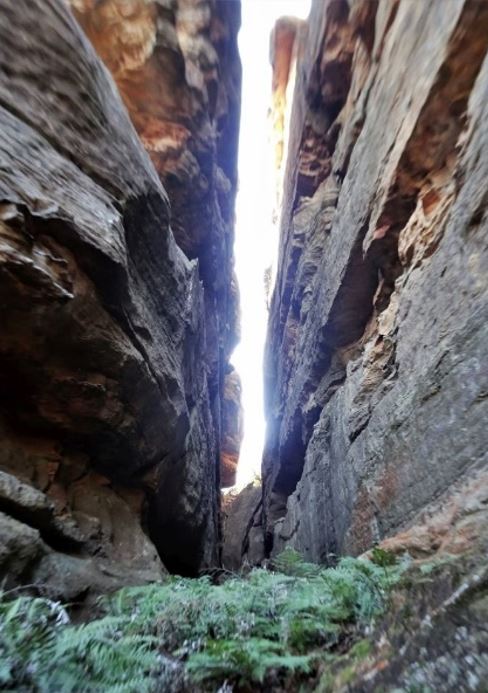
Torbane Slot
Is located on the north western slope of Mount Airly, 800m from the top and below the northern section of Torbane Balcony. Named by Yuri Bolotin and Peter Medbury on a bushwalk 14 June 2021. Yuri recorded, "The almost parallel 50 m high walls stood only 1-2 m apart... The first 50 m nearly flat and covered in green Ferns, mostly Blechnum sp.".
Totem Pole
Is a loosely consolidated rock column with a protective natural capstone. It islocated 240m upstream of the junction of Houstons Creek and Wolgan River and 45m above the southern bank of the Wolgan River. Measuring 6m in height, it has a circumference at the base of 3.4m and a capstone of 1.5m in width. This 6m high pinnacle was recorded in Joseph Carne's field book, 1907. A captioned photo taken records it as "Earth Pillar, the Pinnacle, Wolgan Valley", c1908. Ref: Department of Primary Industries and State Records. Named as the Totem Pole by Joseph Mack in 1975. Ref: Correspondence from Joseph Mack, 3rd March 2009.
Tower of Hope
Located within Hecates Cauldron, is accessed from The Dungeon and gives one of the best iconic views of the Greater Blue Mountains National Park. Looking north, there are magnificent massive smooth and rounded pagodas, with further views over the Capertee Valley and Pantoneys Crown. Named by Yuri Bolotin, 29th August 2015 as the symbol of hope for protection of the entire Gardens of Stone area.
Town of Airly *
Was settled in the 1880s, following the discovery of shale oil in 1883. Proclaimed as such on the 4th September 1897, by the 1920s, it was a ghost town. The first lease on the southern portion of the Airly shale deposit was taken up by the original prospecting party of Messrs Melliday, Massey, Bulkeley, Nicholson and Larkin and was known as the Genowlan Mine. This group failed to meet the necessary labour conditions and the lease lapsed. A new lease of 420 acres was taken up by Mr D. Wilson in late 1890, in turn, this lease was purchased by a German owned syndicate called the Genowlan Shale Company. A more fulsome account of the changes in ownership of the various mining leases and the interlocking relationship between Airly with the adjoining village of Torbane is documented by Mills, and also by Taylor, Greg. J. The Glen Davis Story, History of the Capertee Valley Shale Oil Project. Undated, p. 4.
Tramway Trail
Located at Airly and has been designated by the NPWS, and so chosen as it roughly approximates the horse drawn tramway which linked the North Hartley Mine output to an aerial ropeway in a south westerly direction over the cliff edge to the retorts at Torbane, c1885. The trail sign was erected in 2014. The trail starts at the intersection of the Airly Mountain Trail. No end point is designated. This road ends at GR 218 350, unbelievably at the cliff edge.
Treasure Chest Spur
Is located at Airly it trends in a north east direction from GenowlanTrig to above a tributary of Genowlan Creek. So named by Brian Fox on a Bush Club walk, 27th July 2015 after the nature's mastery of a treasure trove of pagodas and views. Also in keeping with the name Treasure Point to the east.
Treasure Point
Is located 1.2km north east of GenowlanTrig Station, Airly. Named by Brian Fox on a Bush Club walk, 27th March 2013. This high point show cased the natural treasure of God's creation in the multiple pagodas; also, in the morning before starting this walk, Brian had photographed Col Ribaux's sample of diamonds found on this plateau.
Tree Fern Waterfall
Is located within Nayook Creek downstream of Deep Pass and The Slot. It is part of the Green Room. This is a descriptive name coined by the Woody Pear Walking Group in 1994. Ref: Olive Noble's track notes, 23rd May 1994.
Trident Pass
after Neptune’s Trident, is a triple complex of passes located in one wide gully that allows access from the western side of the Wolgan cliff line. Located 700 m due south of Wolgan View Lookout. Named by Michael Keats on a Bush Club walk, 16th February 2015.
Trolls Bridge
Is a very narrow saddle located on the north east side of Pantoneys Crown that gives access from Dominic Dellalibera's property, Ngamperi, to the base of Pantoneys Crown. Named by Dominic as he felt no other creature could have devised such a magical formation.
Tuiwon
William Mylecharane (1832-1917) licensed surveyor in 1892 recorded the Aboriginal name for, The Vale of Clwydd as, Tuiwon. Ref: Smith, Jim. Does the Cox River have an Aboriginal name? Blue Mountains Historical Society, Hobby’s Outreach Vol. 28; No. 3, June – July 2016.
Tunnel 55
Tunnel Creek *
Is about 4km in length. It rises about 4.5km east, north east of Wolgan Pinnacle and flows generally north west into the Wolgan River. The Glowworm Tunnel is located midway along Tunnel Creek. This creek was originally named (see) Penrose Creek.
Tunnel Hill
Tunnel Labyrinth
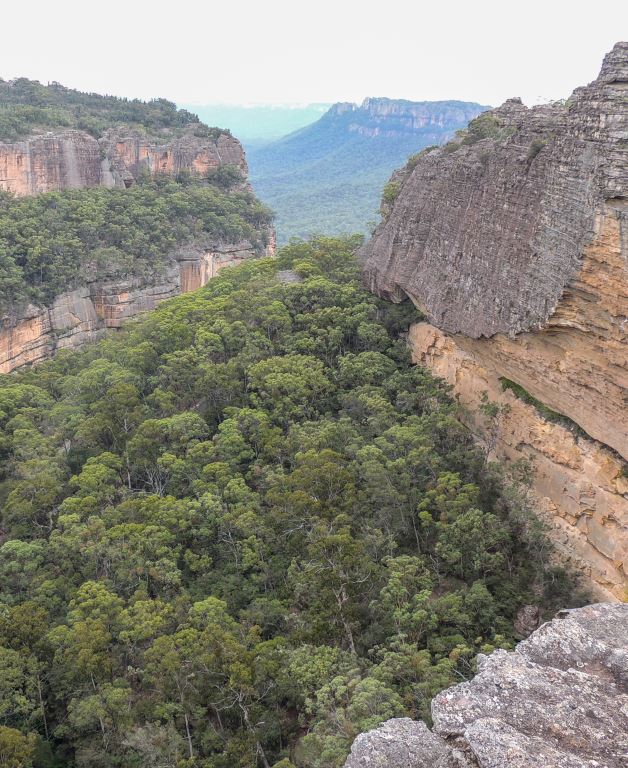
Tunnel Point

Tunnel Terrace Gorge
Turquoise Pool
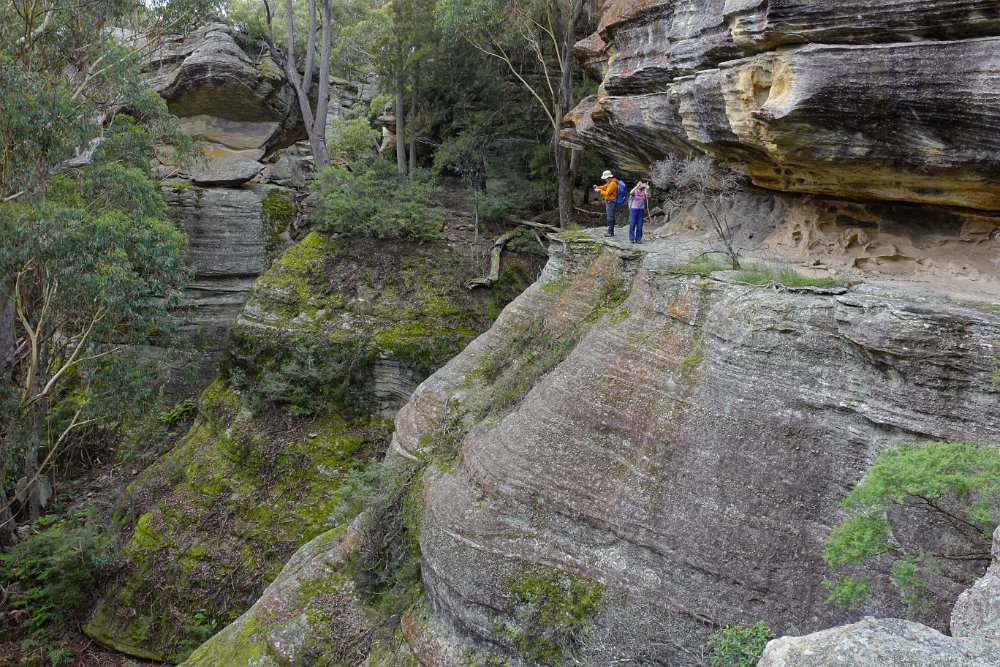
Turret Terrace
Is located 350m north east of Airly Turret and 270m south of the communication tower, Airly. This relatively flat ledge (terrace) extends for 300m within an overhang 15m below the top cliff line and 30m above the forest floor. Named on a bush walk, 17 April 2021, by Yuri Bolotin and Peter Medbury after the nearby feature, Airly Turret.
Turtle Rock
Is a natural erosional rock which has given this beast an eye socket and a quizzical smile. Located above and south of Pandoras Box within Hecates Cauldron, Named by Yuri Bolotin, 29th August 2015.
Twilight Creek
Rises on the eastern side of Island Mountain between the Devils Pinch and Rocky Creek. This creek flows generally north east for 3km to its junction with the Wolgan River. The name was derived from Twilight Canyon which is near the top of this creek system.
Twin Arch Cave
Also known as Double Arch Cave or Ronald McDonald Cave, is located on the northern side of a small gully above the main cliff line, 160m south, near the end of Fire Trail No. 7, which in turn is off Glowworm Tunnel Road. It was accidentally discovered on 20th March 2013 by a bushwalker who misinterpreted information received from rock climber Karen Coghill. He gave it the descriptive name Twin Arch Cave due to a natural arch dividing this overhang in two.
Twin Heads
Relates to a huge outcrop of rocky cliff line and pagodas. Located 2.5km north west of Blackfellows Hand Trail and Kangaroos Creek Road. Named by Hugh Speirs 15th June 2013.
Two Towers
Tyldesley *
Is a locality name that comes from Tyldesley, Lancashire, United Kingdom, where Tyldesley Coal Mine was operating from the 1850s. The village of Tyldesley via Cullen Bullen came into existence to house the employees of the Great Western Colliery from 1904. In 1916, Tyldesley Coal Mining Co. Ltd took it over. The village ceased to exist by the early 1960s. Tyldesley Public School opened in May 1922 and finally closed in December 1963. Ref: Christison, Ray. History of Tyldesley Village, 2003. Today, Tyldesley is a rural place 2km north west of Cullen Bullen, accessed via Tyldesley Road.
Tyldesley Colliery Siding
Opened on 27th August 1909 as Great Western Colliery Siding; by 1960, the siding was abandoned.
Tyldesley Grikes
Refers to the many very deep grikes or slots on the north eastern side of Tyldesley Hill. Named by Michael Keats on a Bush Club walk, 2nd November 2012.
Tyldesley Hill *
Is located on Ben Bullen Range between Castlereagh Highway on the east and the railway on the west. It is 1.9km north, north west of Cullen Bullen. The top of this hill is surmounted by Cullen Bullen Trig Station at 1066m. Tyldesley Hill takes its name from this village.
Ultimate Chute
Is an unbelievable slot partly seen from the Ultimate View which gives access to the eastern side of Airly, from the headwaters of Dog Trap Creek and Glen Davis Road to the top of the cliff line. Located 300 m south east of Genowlan Trig. This almost 100 m high slot (no ropes required) was named by Daryl Watson on a Bush Club walk, 10th August 2015.
Ultimate Slot
Was so named by Brian Fox on a Bush Club walk, 2nd March 2015 after the experience of viewing the Ultimate View. Located 700m north, north west from Genowlan Trig. This slot is 50cm to 3m wide, 55m long and 80m high. The walls are parallel all the way to the top and the lateral displacement is constant. High above where light can enter, four chock stones are positioned at regular intervals.
Ultimate View
Refers to the most stupendous outlooks from the top of Citadel Spur 480m near due south of Genowlan Trig . Views across the Capertee Valley and the peaks of all the surrounding mountains, plus the majesty of Pantoneys Crown . Named by Sheila Zaman on a Bush Club walk, 2nd March 2015.
Undercliff Track
This track roughly follows underneath the top cliff line of Hassans Walls Reserve, from Hassans Glen to above the cliff line at Heffernans Pass. This track over time has been closed due to rock falls and neglect. The Lithgow Mercury, 5th May 1916, p. 6, records, “The Shire Engineer, Mr G. F. Allman….had surveyed the track under the cliffs at Hassan’s Walls for a length of 50 chains(one kilometre)…site of the new Undercliff track.” Graham Holbeach, records, “I have an association with Padleys Pass (the Undercliff Track) which was constructed between 1915 and 1920…..Jim Smith had come across a single photo labelled something like “The Undercliff Track at Hassans Walls.” I think this is the first he had heard of it. The two of us went to look for it. He figured it would probably be somewhere near the main lookout. From the look out, I spotted a benched track heading down a gully. Except where the track crossed coal mining induced landslides, it was easy to follow, as the area was very dry. We found four entry tracks including a magnificent buried set of cut stone steps, as well as caves, rock seats and a bush table and seat. Jim, the late Wilf Hilder and I overhauled the track system and completed the unfinished western section. I did the heavy work of creating the sections across the landslides using a sledgehammer and mattock. I took two sickies and camped beside the track to finish it by the 'deadline'…… He (Jim) …produced two maps plus a two page info sheet with time line for the reopening on 24/11/90 by the Lithgow mayor. We had over 100 attending”. Jim Smith also records that Bernie Wilkes was part of the team which helped restore the track. Ref: The Journal of the Sydney Speleological Society, Vol. 60; No. 7, July 2016; No. 725, p. 185.
Upturned Giants Table
Utopia Room
Has an overall length of over 80m, and there are two distinct sections, one narrow and one wide with a vertical wall at the end. Located on the northern side and above the headwaters of Canobla Creek, 1km south, south east of Point Anderson. Named by Yuri Bolotin on a Bush Club walk, 20th April 2017. Yuri recorded, “When during our previous trip, we had been standing above the slot and peering down into it, we were enthralled by the vision of long parallel walls, framing a rectangular space of almost perfect proportions; green, luxuriant tops of ferns and rainforest trees completed a beautiful, immaculate, somewhat utopian vision of a hidden paradise.”
Vale of Clwydd
Governor Macquarie named the Vale of Clwydd on 29 April 1815. After leaving the base of Mount York he described his party’s route along Cox’s Road:“we pursued our journey in the carriage over a fine plain verdant country of open forest land through a beautiful extensive vale of five miles which I have named the Vale Clwydd after the vale of the same name in Wales". William Mylecharane (1832-1917) licensed surveyor in 1892 recorded the Aboriginal name for, The Vale of Clwydd as, Tuiwon. Ref: Smith, Jim. Does the Cox River have an Aboriginal name? Blue Mountains Historical Society, Hobby’s Outreach Vol. 28; No. 3, June – July 2016.
Valley of the Caves
Is within a small valley 900m south east of Beecroft Trig and south of Beecroft Firetrail. The base of the cliff line is studded with numerous overhangs. Named by Michael Keats on Bush Club walk, 16th June 2014.
Valley of the Dinosaurs
Refers to a narrow, deep canyon which forms part of the headwaters of Genowlan Creek. It is located 500m north, north east of Genowlan Trig Station. Named by Bruce Mullaney, a bushwalker with the Central West Bushwalking Club, in 2001. When he gazed down from the top rock platform into this hidden canyon, it looked prehistoric. Note this feature had been previous named as (see) Hidden Valley.
Valley of the Kings
Is a pagoda lined tributary in the upper reaches of Genowlan Creek. Located 1km north east of Genowlan Trig Station. The western end of this ravine has a 10m drop. Named by Dr Haydn Washington, November 1984. Ref: Correspondence with David Blackwell, 27th April 2010 and Haydn’s map.
Valley of the Swamps *
Is located in the Blue Mountains National Park, 7.2km east, south east of Deep Pass and about 6km south, south east of Rock Hill. Name shown on the 1:63 360 Army Survey Corps Wollangambe Map. Named by Lieutenant Colonel Clews, Royal Australian Survey Corps, survey party, 1930. Ref: Gough, Noel R. "The Major" Lt. Col. Hugh Powell Gough Clews.
Vertigo Slot
Is located 1.8km north east of Invincible Trig. Named by Yuri Bolotin, June 2013. Yuri recorded, looking at it from the top, it is so steep and narrow, and it gives you a sense of vertigo.
Wallerawang *
Various spellings have been recorded for Wallerawang: Walerawang, 12th November 1823, Surveyor James McBrien, native name of the creek, (Coxs River). Ref: Field Book 205, State Records: NRS 13889 [SZ205]. Wallerawang, 1830. Ref: Survey Plan 8.691 by James Byrne Richards. Wallerawang, 1833. Ref: The Surveys of the Australian Agriculture Company, published 1st September 1833. Wallerowong, 1856. Spelling as per grave stone erected by Archibald James Walker "in memory of Bobby and the Wallerowong Aborigine Tribe". Same spelling recorded by Archer, Thomas. Recollections of a Rambling Life, 1897, p. 14. Wallerrawang, 1875. Ref: Lang, John Dunmore. An Historical and Statistical Account of New South Wales, 1875, Vol. 2, p. 201. Note: the present spelling is the same as the 1830 and 1833 reference. Colloquially by the locals, the village is referred to by the diminutive "Wang". This aboriginal name according to Helen Riley, Wiradjuri Elder and Sharon Riley, Wiradjuri representative means 'Place of Wood and Water. Ref: Oral history 3rd May 2016.
Wall of Teeth
Is a narrow rocky outcrop on the north south spine between Red Rocks and Mount Dawson. Named by Dr Haydn Washington, c1984. It is aptly named for the serrated projecting ironstone ledges that from below give it the appearance of either dragon's back or a buzz-saw blade, depending on your point of view. Ref: Correspondence with Haydn Washington, 30th May 2010.
Walls of Jericho
Refers to the cliff line on the southern side of the Wolgan River midway between Devils Pinch and Rocky River. Name recorded in Taylor, Pete and Penney, Andrew. The Wolgan Guide, 1984, p. 25.
Wall Wall
Is the Aboriginal name for Blackmans Crown. Ref: Smith, Jim. Wywandy and Therabulat. The Aborigines of the Upper Coxs River and their association with Hartley and Lithgow, 1990. Smith records that Wall Wall is a Gundungurra name.
Wangcol Creek *
Is about 7km in length rising north west of the town of Wallerawang. This creek was named after the name, Wallerawang Colliery. The word, "Wang" is the slang name for the locality. The colliery closed about 1985. Its headwaters are on the northern side of the Mount Piper Power Station and flows generally south east into the Coxs River. The name was assigned by the Geographical Names Board, 7th May 1993.
Waratah Ridge *
Trends from the Blue Mountains Range 3.5km west of Mount Horne in a generally eastern direction for about 13km. This is a descriptive name, as each year many Waratahs flower there from around October. A part of this ridge is traversed by Waratah Ridge Road.
Watch House Creek *
is a non perennial creek rising on the eastern slopes of the Great Dividing Range 3.5km south, south east of Mount Alloway. It flows generally north and north east for about 4km into Alloway Creek. So named after the Watch House (police lockup) that was located on the southern side of Capertee. Ref: The Sydney Gazette, 12th August 1837, p. 4 which records tenders called for erecting a watch house at Roxburgh. Shown on the map Parish of Coco, 1883.
Watch Towers
Is a conjoined group of pagodas above the cliff line, 400m south west of Woolpack Rock and 1km south east of Hughes Defile. This viewing location has extensive views across the Wolgan Valley, hence its name. Named by Michael Keats and Brian Fox on a Bush Club walk, 27th May 2016.
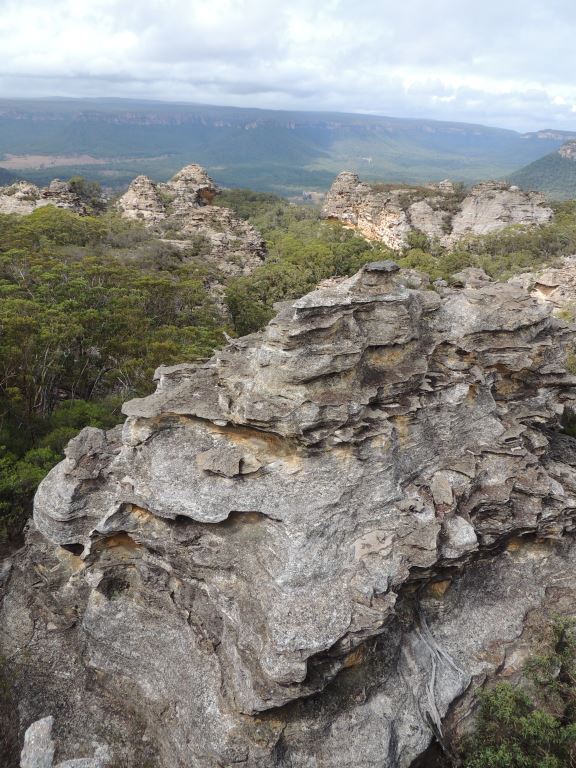
Watch Tower Spur
Is a significant spur that runs diagonally across an area known as Alcatraz at an altitude of over 1000m; it has the feature called Watch Towers on its southern end. The spur offers spectacular 360 degree views along most of its length. Located 300m to the west of Woolpack Rock. Named by Yuri Bolotin, Michael Keats and Brian Fox on a Bush Club walk on 27th February 2017.
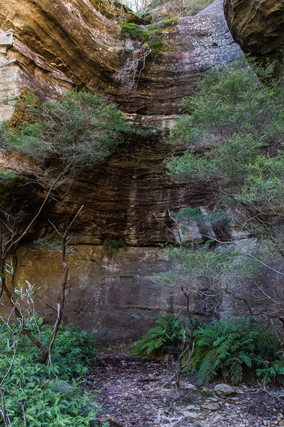
Waterfall Ledges
Were named by Yuri Bolotin on a Bush Club walk, 15th August 2013. Located 1.3km north east of Invincible Trig Station, these successive ledges can be walked and explored. The top ledge of variable width trends for some 60m into a hook shaped arc, where there is a small waterfall.
Weather Cave
Is located off Glowworm Tunnel Road and Fire Trail No. 7. It is a long, narrow overhang running up the side gully adjoining and on the northern side of Rain Cave. This overhang was surveyed by Ross Ellis and Erik Halbert on 18th October 2006. Ref: The Journal of the Sydney Speleological Society, 2007, 51 (5); pp. 134-138.
West Side Chamber
100 metres north of West Side Falls, a weathered cavern of eroded red brown sandstone over 100m in length. Both features are 2.6km west of Cockatoo Hill. Named by Yuri Bolotin on a bush walk, 22nd May 2015. .
West Side Falls
Is a beautiful finely dispersed waterfall dropping about 50m as a single drop and onto a dome shaped mound. Located on the western side of East Creek and 700m downstream of East Creek Falls. Named by Yuri Bolotin on a bushwalk, 22 May 2015.
